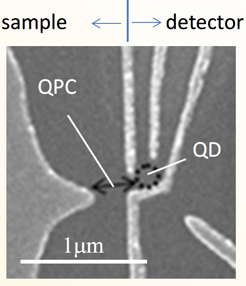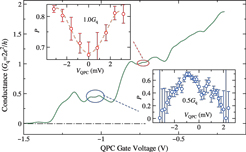Nature of Spin Polarization in a Quantum Point Contact
Katsumoto Group
Creation of spin current in quantum structures of non-magnetic materials is a key technique in semiconductor spin-electronics (spintronics). The use of spin-orbit interaction (SOI) and quantum point contact (QPC) structure is a promising candidate. So called Rashba-type SOI splits electronic spin states according to the direction of momentum. Electronic states in a QPC structure are a set of one-dimensional bands with discrete edges due to quantization transverse to the one-dimensional motion. As a result, ordinary conductance of a QPC is quantized with the unit of 2e2/h, which is called conductance quantum. There are a number of experimental reports on the anomalous quantization of conductance at a half conductance quantum, i.e. e2/h, which phenomenon, called 0.5 conductance plateau has been attributed to the result of perfect spin polarization [1] though direct evidence was not obtained. Such a high spin polarization was also predicted on the 1.0 plateau (i.e. 2e2/h) [2] but due to the lack of detection method, there have been no experimental confirmation.

Fig. 1. Scanning electron micrograph of the gate configuration for the sample. The gray regions are metallic Schottky gates.

Fig. 2. QPC conductance as a function of the gate voltage. The unit is the quantum conductance Gq=2e2/h. The insets show bias voltage (VQPC) dependence of spin-polarization of 0.5 Gq and 1.0 Gq plateaus respectively.
We have developed a new technique for the detection of spin-polarization with time-domain spin blockade. For that the two-electron tunneling process from the target device to a quantum dot (QD) is used. When the process is to a single orbital level, the probability is suppressed while it is not for the tunneling into two orbital levels. Hence the degree of suppression has a direct relationship to the spin-polarization in the target with the spin-relaxation time in the QD as a parameter.
As the base system, two-dimensional electron gas (2DEG) in an (In, Ga)As quantum well was adopted. The sample consists of a QPC with a side-coupled QD with another QPC for the remote charge detection (Fig. 1). The conductance of the QPC as a function of the gate voltage shown in Fig. 2 clearly exhibits 0.5 anomalous plateau structure in addition to the ordinary quantized plateau at 2e2/h. Spin-polarization measured with the QD detector is shown as a function of the QPC bias voltage VQPC in the insets of Fig. 2, both for 0.5 and 1.0 plateaus. Here the definition of spin-polarization P is P = (Nu–Nd) / (Nu+Nd), where Nu and Nd correspond to the concentration of up-spin electrons and down-spin electrons respectively. At zero-bias voltage, P is high on 0.5 plateau while it decreases with increasing VQPC. The differential conductance of the QPC, on the contrary, increases with VQPC indicating that the mechanism of the spin-polarization is a kind of spin-filtering, which cuts the flow of spin-down electrons. On the other hand at 1.0 plateau, P gradually increases with VQPC, indicating that the mechanism here is spin-rotation, which turns up the down spin of electrons. There is a small dip structure in P near the zero-bias at 0.5 plateau, which reflects the formation of the Kondo cloud. As just described we have demonstrated the powerfulness of the present method and revealed the mechanisms of spin-polarization in a QPC with Rashba-type SOI.
References
- [1] P. Debray et al., Nature Nanotechnology 4, 759 (2009).
- [2] M. Eto, T. Hayashi, and Y. Kurotani, J. Phys. Soc. Jpn. 74, 1934 (2005).
- [3] M. Kohda et al., Nature Communications 3, 1082 (2012).
